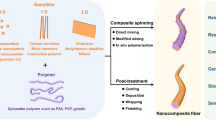Abstract
Carbon nanotube reinforced polymer composites have been extensively researched [Shadler LS, Giannaris SC, Ajayan PM (1998) Appl Phys Lett 73:3842; Ajayan PM, Shadler LS, Giannaris C, Rubio A (2000) Adv Mater 12:750; Wagner HD, Lourie O, Feldman Y, Tenne R (1998) Appl Phys Lett 72:188; Thostenson ET, Chou T-W (2002) J Phys D: Appl Phys 35:L77] for their strength and stiffness properties. The interfaces between nanotubes and polymer matrix can play a critical role in nanocomposites for their mechanical properties, since the interfacial area is order of magnitude more than traditional composites. Unless the interface is carefully engineered, poor load transfer between individual nanotubes (in bundles) and between nanotubes and surrounding polymer chains may result in interfacial slippage [Shadler et al. (1998); Ajayan et al. (2000)] and consequently disappointing mechanical stiffness and strength. Interfacial slippage, while detrimental to high stiffness and strength, could result in very high mechanical damping, which is a hugely important attribute in many commercial applications. In this paper, we show that the mechanical damping is related to frictional energy dissipation during interfacial sliding at the extremely many nanotube-polymer interfaces, and characterize the impact of activation of the frictional sliding on damping behavior.



Similar content being viewed by others
References
Shadler LS, Giannaris SC, Ajayan PM (1998) Appl Phys Lett 73:3842
Ajayan PM, Shadler LS, Giannaris C, Rubio A (2000) Adv Mater 12:750
Wagner HD, Lourie O, Feldman Y, Tenne R (1998) Appl Phys Lett 72:188
Thostenson ET, Chou T-W (2002) J Phys D: Appl Phys. 35:L77
Fisher FT, Bradshaw RD, Brinson LC (2002) Appl Phys Lett 80:4647
Qian D, Dickey EC, Andrew R, Rantell T (2000) Appl Phys Lett 76:2868
Thostenson ET, Zhifeng R, Chou T-W (2001) Compos Sci Technol 61:1899
Li F, Cheng HM, Bai S, Su G, Dresselhaus MS (2000) Appl Phys Lett 77:3161
Barber A, Cohen S, Wagner HD (2003) Appl Phys Lett 82:4140
Zhou X, Wang KW, Bakis CE (2003) Compos Sci Technol 64:2425
Suhr J, Koratkar N, Keblinski P, Ajayan PM (2005) Nat Mater 4:134
Liu A, Huang J, Wang K-W, Bakis CE (2006) J Intel Mater Syst Struct 17:217
Rajoria H, Jalili N (2005) Compos Sci Technol 645:2079
Eitan A, Fisher FT, Andrews R, Brinson LC, Schadler LS (2006) Compos Sci Technol 66:1162
Ding W, Eitan A, Fisher F, Chen X, Dikin D, Andrews R, Brinson L, Schadler LS, Ruoff RS (2003) Nano Lett 3:1593
Painter P, Coleman M (1997) Fundamentals of polymer science. CRC Press, New York
Bower C, Kleinhammes A, Wu Y, Zhou O (1998) Chem Phys Lett 288:481
Monthioux M, Smith B, Burteaux B, Claye A, Fischer J, Luzzi DE (2001) Carbon 39:1251
Koratkar NA, Suhr J, Joshi A, Kane RS, Schadler LS, Ajayan PM, Bartolucci S (2005) Appl Phys Lett 87:063102
Acknowledgement
We acknowledge funding support from the US Army Research Office (Structures and Dynamics Program).
Author information
Authors and Affiliations
Corresponding author
Rights and permissions
About this article
Cite this article
Ajayan, P.M., Suhr, J. & Koratkar, N. Utilizing interfaces in carbon nanotube reinforced polymer composites for structural damping. J Mater Sci 41, 7824–7829 (2006). https://doi.org/10.1007/s10853-006-0693-4
Received:
Accepted:
Published:
Issue Date:
DOI: https://doi.org/10.1007/s10853-006-0693-4




